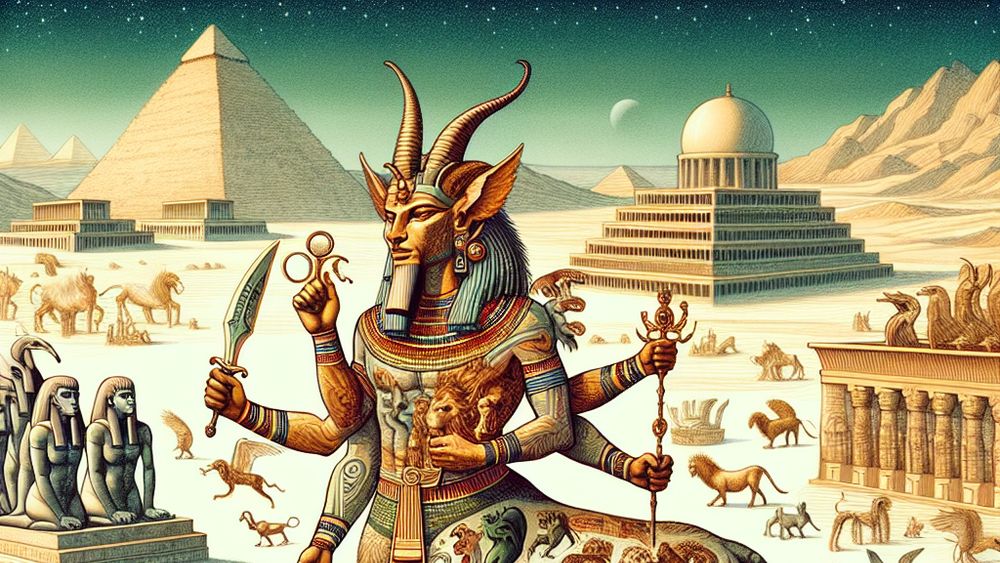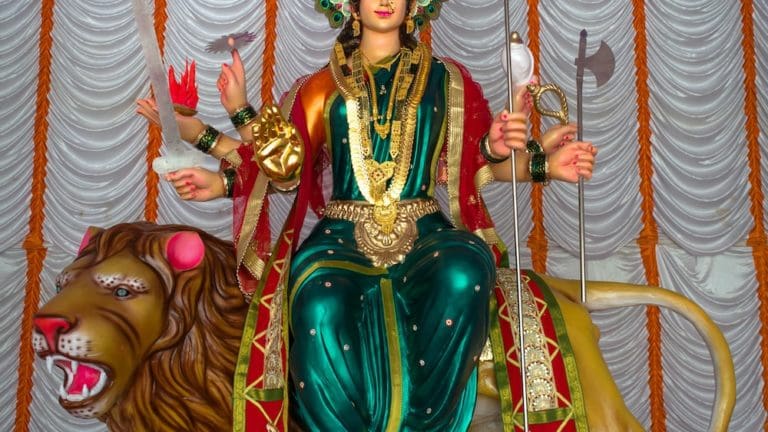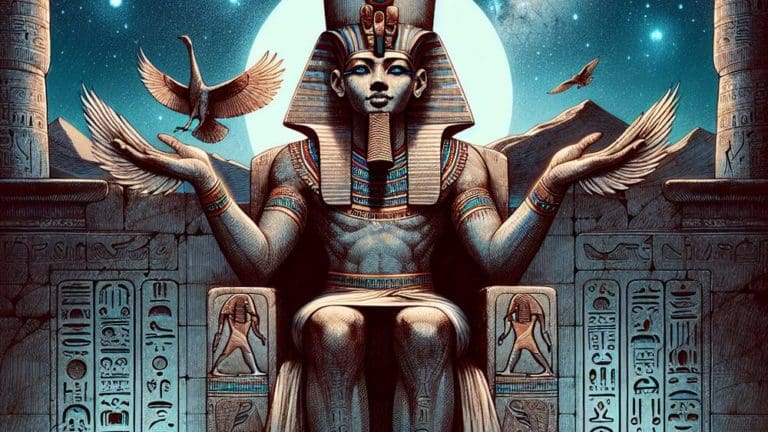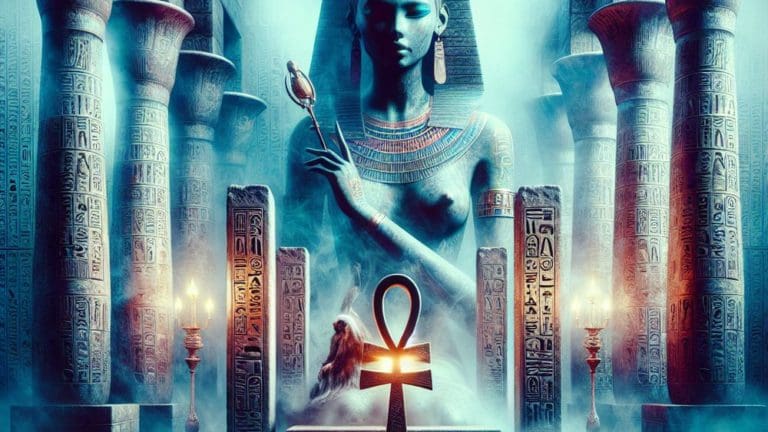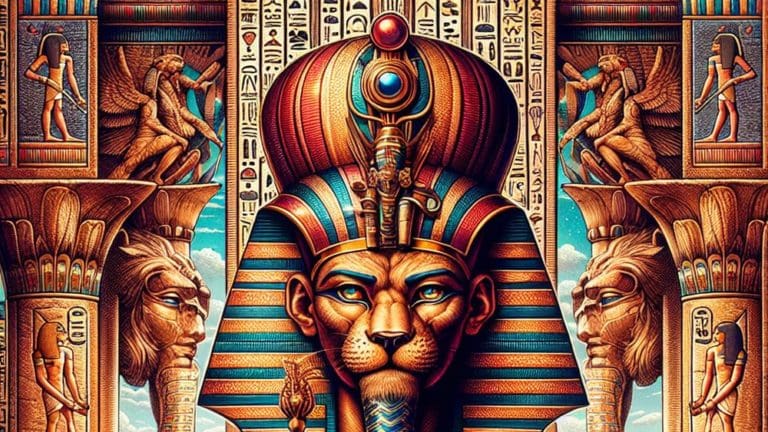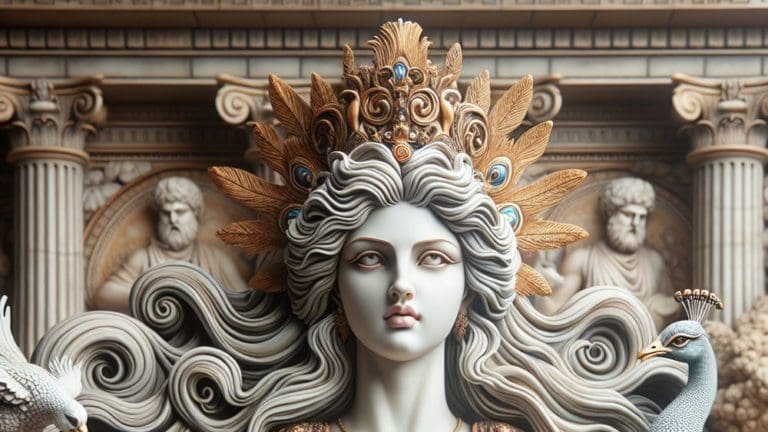The Egyptian God Typhon: Mythology And Origins
The Egyptian God Typhon: Mythology And Origins
Have you ever stumbled upon a tale so intriguing and complex that it sets your imagination on fire? The story of the Egyptian god Typhon is just such a tale, marinating in mystery and shrouded in the mists of time. This formidable figure has captivated historians, archaeologists, and mythology enthusiasts alike, urging us to dive deep into the ancient world’s shadows to uncover the truth.
Key Points:
- Typhon, a key figure in Egyptian and Greek mythology, has a complex origin story involving Gaia, Tartarus, and Echidna.
- Typhon is associated with chaos and destruction in Egyptian mythology, compared to his monstrous depiction in Greek mythology.
- His battle with Zeus on Mount Olympus is a central event, showcasing the clash between order and chaos.
- Typhon’s offspring, including Cerberus, Hydra, and Chimera, reflect his fearsome legacy as the father of monsters.
- Imprisoned beneath Mount Etna by Zeus, Typhon’s breath is said to fuel the volcano’s eruptions.
- Typhon’s influence extends to modern pop culture through video games, movies, and literature, keeping his legacy alive.
- Scholars draw parallels between Typhon and figures from Near Eastern mythologies, highlighting cultural exchanges in ancient narratives.
What makes the narrative of Typhon so compelling? Is it his startling origins, his fierce battles, or the sheer magnitude of his legacy? Join me on this adventurous expedition as we peel back the layers of history to reveal the essence of one of mythology’s most fascinating characters. Prepare to be enthralled by the myths, intrigued by the contrasts, and amazed by the impact of Typhon across cultures and epochs.
The Origins and Mythology of Typhon
The mythology surrounding Typhon is as vast as it is varied, taking us on a journey from the ancient sands of Egypt to the craggy peaks of Greece. This part of our exploration delves into the origins and mythology of this enigmatic figure, setting the stage for an epic tale of divine power, relentless battles, and ultimate conquest.
The Birth and Family of Typhon
Understanding the family of Typhon offers us a fascinating glimpse into the complexities of ancient mythology. Born from Gaia and Tartarus, Typhon was destined from the start to become a force to be reckoned with.
- Mother: Gaia, the earth personified
- Father: Tartarus, the deep abyss
- Spouse: Echidna, often considered the mother of monsters
- Notable Offspring: Cerberus, the three-headed dog; Hydra, the many-headed serpent; and Chimera, a monstrous fire-breathing creature
These family connections paint a picture of Typhon not just as a formidable foe but as a progenitor of some of the most fearsome creatures in mythology, adding layers to his already intricate story.
Typhon’s family lineage reveals a rich tapestry of mythological connections, showcasing his role as a powerful figure and progenitor of legendary creatures.
Typhon in Egyptian Mythology vs. Greek Mythology
In Egyptian mythology, Typhon is often associated with Set, the god of chaos, storms, and the desert. This association lays bare the multifaceted nature of Typhon, integrating him into the pantheon of one of history’s most enigmatic cultures. The Egyptian depiction emphasizes Typhon’s destructive aspects and his role as a force of disruption within the divine order.

Greek mythology, on the other hand, offers a different lens through which to view Typhon. Here, he is typified as a gigantic monster, the offspring of Gaia and Tartarus, challenging the might of Zeus and seeking to overthrow the Olympian order. The Greeks focused on Typhon’s monstrous nature and his epic confrontation with Zeus, illustrating the eternal struggle between order and chaos.
The Battle of Typhon with Zeus
The battle between Typhon and Zeus is one of epic proportions, a defining moment in the annals of mythology that highlights the clash between order and chaos.
- Setting: The fierce battle took place on the slopes of Mount Olympus, the home of the gods.
- Weapons: Typhon employed his control over wind and fire, while Zeus wielded his thunderbolts.
- Outcome: Zeus emerged victorious, sealing Typhon beneath Mount Etna.
This confrontation not only cemented Zeus’s status as king of the gods but also underscored the themes of strength and resilience that are central to many mythological tales.
The battle between Typhon and Zeus symbolizes the clash between order and chaos, emphasizing themes of strength and resilience in mythological tales.
The Many Faces of Typhon
The legend of Typhon is rich with descriptions and symbolism, manifesting in a multitude of forms across various cultures and stories. This plurality of identities underscores the complexity and depth of his character, inviting us to explore the manifold ways in which Typhon has been imagined and remembered through history.
Physical Descriptions and Symbolism
Typhon’s physical form is as varied as his mythology, with descriptions ranging from a fearsome giant to a creature composed of multiple terrifying beasts.
| Feature | Description |
|---|---|
| General Appearance | Often depicted as a massive monster combining human and animal elements |
| Heads | Described by some sources as having numerous heads of dragons or serpents sprouting from his shoulders or hips |
| Body | His lower half is frequently likened to a coiled serpent, signifying his connection to the earth and the underworld |
| Eyes | His eyes are said to emit flames, underscoring his fiery and destructive nature |
These varying descriptions highlight the symbolic importance of Typhon in ancient mythology, representing chaos, strength, and the untamable forces of nature itself.
Typhon’s Offspring: The Father of Monsters
Typhon, the terrifying entity born from Gaia and Tartarus, was not only known for his fearsome battles but also for his progeny. These offspring, a bizarre array of creatures, have captivated the imagination of those exploring Greek mythology. Among these monstrous children were:
- Echidna, the half-woman, half-serpent who became the mother of many other monsters.
- Cerberus, the massive three-headed dog guarding the gates of the Underworld.
- Hydra, the serpent-like creature with multiple heads that regrew two for every one that was cut off.
- Chimera, a fire-breathing hybrid with the body of a lion, the head of a goat, and the tail of a serpent.
These offspring represent the strength and fear Typhon instilled in the gods and humans alike. Each monster offers a tale of heroism and terror, continuing Typhon’s legacy throughout mythology. Their stories, filled with conflicts and resolutions, serve as a testament to Typhon’s lasting impact on Greek myths.
The Imprisonment Beneath Mount Etna
The tale of Typhon’s imprisonment is one of cataclysmic defeat and eternal punishment. Following a ferocious battle with Zeus, wherein Typhon aimed to overthrow the king of gods, he was vanquished and entombed beneath Mount Etna. This imprisonment represents not only Zeus’s ultimate supremacy over the titans and monsters but also a melding of myth and the natural world.
The eruptions of Mount Etna are said to be the breath of Typhon, a reminder of his fiery temper and the battle that led to his downfall. The mountain, therefore, stands as a monument to the strength and fury of the forces that once clashed in mythology, intertwining geological phenomena with the tales of gods and monsters.
Typhon’s imprisonment beneath Mount Etna intertwines myth and the natural world, symbolizing the clash of ancient forces and the enduring power of mythological tales.
Typhon’s Influence and Legacy
The influence and legacy of Typhon extend far beyond his offspring and his battle with Zeus. As a symbol of chaos and opposition to the Olympian order, Typhon’s story has permeated various cultures and continued to fascinate those studying mythology. His tale prompts exploration into the nature of evil, the concept of hubris, and the dynamics of power in the mythological narrative.
Typhon and the Near Eastern Influence
The figure of Typhon has echoes in other ancient mythologies, indicating a cultural exchange among civilizations. Scholars have drawn parallels between Typhon and figures from Near Eastern mythologies, such as:

- Set, the Egyptian god of chaos, storms, and disorder.
- Tiamat, the Babylonian goddess associated with creation, the sea, and chaos.
- Leviathan, a creature from Hebrew mythology often associated with the sea and chaos.
These connections suggest that the story of Typhon was not isolated but part of a broader tapestry of myths dealing with the cosmological struggle between order and chaos. Cross-cultural influences enriched the narrative of Typhon, integrating aspects of Near Eastern deities and monsters, and highlighting the universality of certain themes in human storytelling.
The Cultural Significance of Typhon in Ancient Societies
In ancient societies, Typhon was more than just a monster; he was a symbol of the primal fears and the chaotic forces that could overthrow order and harmony. His defeat by Zeus served as a narrative reaffirming the strength and legitimacy of the Olympian gods, ensuring the stability of the cosmos from the forces of chaos.
Art, literature, and ritual practices of ancient Greece often depicted or referenced Typhon, underscoring his role in the cultural psyche as the embodiment of ultimate evil and disorder. This depiction served as a cautionary tale, reminding individuals of the strength found in unity and order against the tumult wrought by uncontrolled forces.
Typhon in Modern Pop Culture
Despite being a figure from the deep past, Typhon’s influence persists in modern pop culture. This ancient monster is represented in:
- Video games, where players often encounter Typhon as a formidable adversary or as part of the game’s mythology.
- Movies and television shows, where his story is adapted or referenced to add depth to narratives involving battles against evil.
- Literature, particularly in fantasy genres, where his offspring and battles inspire new tales filled with magic and heroism.
These representations maintain Typhon’s legacy alive, transforming him from a symbol of primordial chaos to a fascinating character that continues to inspire storytelling across mediums.
Typhon’s influence endures in modern pop culture through various mediums, transforming him into a captivating character that inspires storytelling.
FAQs
1. How is Typhon related to the Egyptian god Set?
Typhon’s association with the Egyptian god Set stems from similarities in their roles as gods of chaos and destruction. Both deities exhibit traits that personify the forces of disorder, making their connection a subject of intrigue among scholars.
2. What are some of Typhon’s most famous offspring?
Some of Typhon’s most famous offspring include the multi-headed serpent Hydra, the Nemean Lion, and the Chimera, each representing unique monstrosities that have fueled countless myths and stories.
3. How did Typhon come to be imprisoned beneath Mount Etna?
Typhon came to be imprisoned beneath Mount Etna following a cataclysmic battle with Zeus. After being defeated, Typhon was trapped under the mountain, where it’s said his fiery breath fuels the volcano’s eruptions.
4. In what ways does Typhon appear in modern culture?
Typhon makes appearances in modern culture through various media forms, including books, video games, and movies, where his legacy as a formidable force and father of monsters continues to captivate audiences.
Conclusion
In our journey through the annals of mythology, the Egyptian god Typhon stands out as a fascinating figure whose legacy stretches from the depths of ancient manuscripts to the heights of Mount Etna. By exploring Typhon’s origins, mythologies, and influence, we not only gain insight into the ancient world but also enrich our understanding of how these myths contribute to our cultural fabric. So, let us continue to peel back the layers of history, unraveling the stories that have shaped our collective imagination.
In this spirit of relentless curiosity, I invite you to join me in further explorations of the past, uncovering the secrets and lessons that lie buried in time. Thank you for accompanying me on this journey into the heart of mythology, where the echoes of heroes and gods still resonate. Until next time, keep seeking the untold stories hidden in the shadows of history.
Warmest regards,
Cedric

